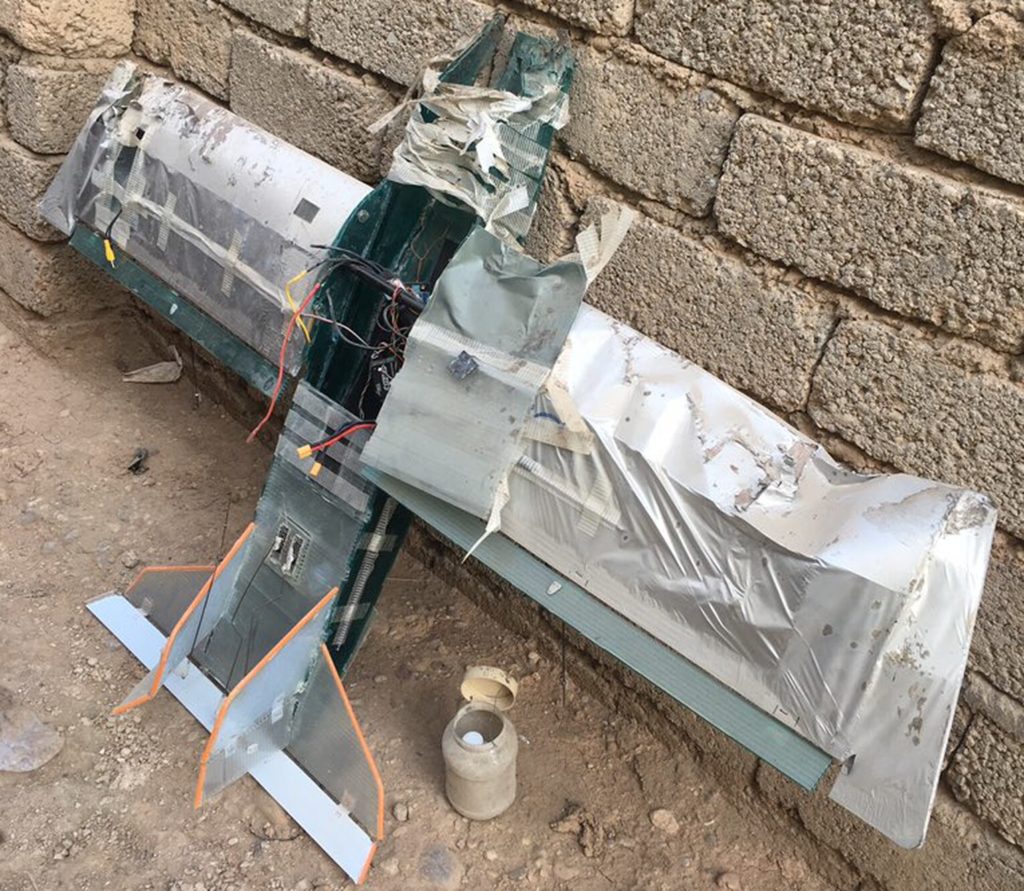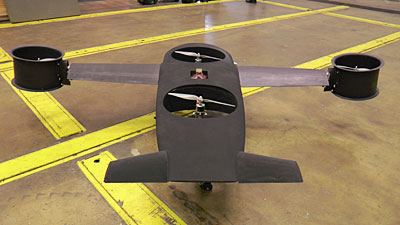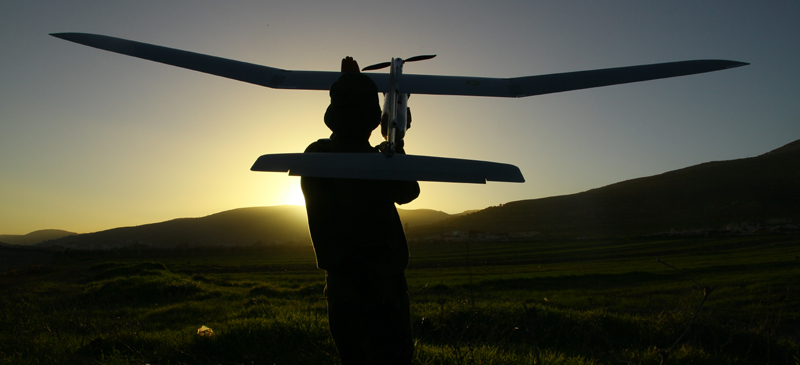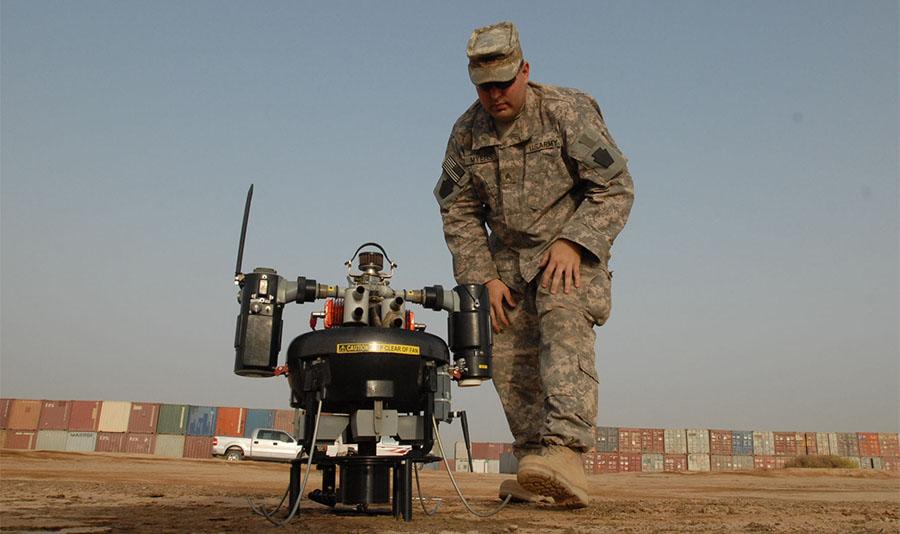If we consider geopolitics as a game of individuals, we might perceive the following: One madman contemplates his own mortality and as he withers in the mirror, he wishes to take us all down with him. The bare knuckle bear slayer, now impotent and shriveled, old age plain for all to see, wishes to reassert himself, sending young men to their deaths for his vanity. Grist for the mill, but how many dead will it take to prepare his youth potion? Dead children splayed on concrete, bleeding out slowly, for one man’s ego.
His loss of virility exposes a nation in decline. Keystone cops with nuclear weapons but no rations. Chess players blundering into farcical war crimes. Maybe Russians were never heroes or martyrs, they’ve just always been good at dying for lost causes? Yet, he is far from the only example of a powerful isolated authoritarian with silly ideas and a weak mind.

An ISIS drone made in the field.
In Asia, South America, the U.S., and Europe, we have several specimens of men who are rolling back democracy and emboldening the nationalistic extreme right. Jingoism, xenophobia, hate, racism, sexism, all abound. Institutions that have taken decades to build crumble before them as they disassemble: rule of law, an independent judiciary, central bank independence, and a free press.
Hate the other, love me; I will protect you. It’s a refrain that has distinct echoes from our history, one that should give us pause. But, the buffoons on the ramparts continue to raise their fists, decrying this or that imagined enemy, refusing to take any responsibility for anything. Online debate is crammed with misinformation and those who complain the loudest see their voices reverberated globally. We do not share a central truth. Across nations and within them, cooperation and solidarity is absent. Against that backdrop a legion more await, peddling other flavors of hate. Kill the dictator; long live the new dictator.

Boeing built and flew this drone within a month.
We’re seeing a new geopolitical reality take place before our eyes. The old world order is crumbling before us. On the one hand, we’re witnessing a coming together of disparate countries around core values while people the world over are united in opposition of an evil storm gathering. On the other, murderous leaders are emboldened by the lack of cohesion and collective force globally. The world is disintegrating.
Globalization has not made us one global village, but a hostile series of hamlets—some on fire, none really completely trusting the other. We’re seeing that globalization, the WTO, and the old order have their limits. The U.S. essentially executed ZTE and harmed Huawei. Countries are worried about China’s influence in Africa and are looking to curtail it. We’re seeing the hard edges of China’s “peaceful rise.” Europe is momentarily united but weak at the centre and the edges. The U.S. looks weak having withdrawn from Iraq and Afghanistan. Iran’s influence is on the rise throughout Iraq, Syria, Lebanon and beyond. Erstwhile perennial enemies Israel and the Gulf Arab states have become friends, which appears as a magical thing soaked in realpolitik. A dozen states worldwide seem to want to emulate North Korea and live in extreme isolation and total control. Africa remains poor and neglected and its’ boundless entrepreneurial energy has not to date been enough to ameliorate its many issues.
At the same time, thanks to foreign interests and backers, African states look like they are weakening rather than strengthening themselves. Indeed a mercenary group called Wagner, backed by the Russian government, is responsible for much of the online fear-mongering and disinformation. That same firm has effectively taken over the countries of CAR, Mali and Burkina Faso recently making key moves in January and February of this year. Meanwhile, Blackwater echoes similar actions on behalf of the U.S. and China.
Sometimes, therefore, a smokescreen of hate, really is a smokescreen. And, sometimes, many problems from border insecurity to a peeling away from Europe and extremism is traceable to one single person, or a few. South American states are besieged by corruption, bad governance, and autocrats from across the spectrum. Up and down both America’s, violence is on the rise or is already a way of life.

We used to have a first, second, and third world and that conception is still apt. We have a wealthy but relatively sclerotic first world where democracy is being hollowed out by wealthy elites, outside actors, and discontent factions. These societies are aging with few opportunities for the young sitting on a demographic soufflé, waiting to collapse. We have an autocratic alliance of fellow travelers united in their determination to crush any opposition. Rule by fiat of the few keeps all other ethnic or social groups under foot. Extractive industries or successful industrial policy masks deep divisions in society and a lack of innovation while handouts and subsidies are a sop to keep discontent at bay.
And then there is a third world that you may call developing but this won’t hide that much of it is not actually developing. Whatever optimism you have about the governance, infrastructure, and FDI, deprived states of this world have got to come under strain as these states do not really benefit from the highs of global finance while being battered by the lows, such as high oil prices as a result of conflict to which they are no party.
What will the future hold? This is something we do not know. However, in light of the turbulent years in American politics, the rocky European Union with its newly found sense of purpose, a floundering gaggle of poor states, and towering above all the shadow of the Panda, China, we can make some educated projections as to what will happen vis-à-vis our industry.
We know that dictators have seen that they can get away with significant oppression as long as it is not telegenic. As long as the thumbscrews are gradually applied, they can get away with murder. And even if news gets out—in the case of a Ryanair aircraft forced to land in order to torture a passenger or a private jet hunting party flown in along with their bone saws—the world will quickly move on without any real consequence. In a post-truth society, most will be confused, distracted, or misdirected anyways.
We can, therefore, expect more autocrats and for them to work harder to stay in power. We would also expect global leaders to survey world trade and conclude that COVID and the Russian invasion of Ukraine were completely independent disasters that could be portend more similar events. More resilient supply chains, more local production, and a more directed policy on manufacturing critical elements as much as possible in the country will become de rigueur. The dictator and the European country will each wonder how self-sustainable they can really be. How well can they do in a fight? How much isolation can they endure? Aside from all the trust and money laundering that this current environment will push, countries will wonder who their real friends are.
It will be a surprising validation for the North Korean Juche philosophy of radical independence and self-reliance. The pariah state now serves as a model of how the unloved can continue to govern for decades. North Korea’s obsession with nuclear and long-range missiles will no longer be a hobby of one, with many more states wanting to obtain the ultimate get-out-of-jail-free card. Investments in MANPADS missile systems similar to the Javelin will rise significantly. Sophisticated anti-ship missiles and SAM sites will be developed and sell more. Anti-drone technologies will be more prevalent. Sophisticated radar systems will be in great demand across many countries.
Very effective drones will also be acquired by anyone who can afford them. These have played a crucial role in determining the Nagorno Karabakh war and are effective in Ukraine as well. They will be in great demand for their cost-effectiveness, skill in anti-armor roles, and ability to serve as reconnaissance platforms. Armor is looking like a thing of the past, so different modes will have to be found to defend a nation and move troops.
Former Soviet client states will be looking to diversify away from Russian kit in areas where they will gain an edge by buying Turkish TB2 drones or products like South Korea’s K9 Howitzer. Countries such as South Africa could be seen to surge in weapons sales if they are deemed sufficiently neutral. Israeli drones and sensor equipment will also be in short supply as companies look at automated ways to protect zones and borders. Investment in hypersonics is sure to accelerate. The U.S. now sees a confrontation with China and Russia as near possibilities. The nation needs an advantage here or its arsenal will be partially negated. China and Russia will also invest heavily in hypersonics to overtake the U.S. with this one strategic weapons technology.
There will be more grey areas in the world, disputed zones that are on the edge of permanent conflict. More meddling by spy services and aligned troops will be allowed. Previously, proxy wars were fought quite clearly. Now it could be unclear which company and faction supports whom. On the whole, geopolitical risk is elevated for all firms globally, whether you drill for oil in Nigeria or have a call center in Belarus. The world is more fractious and uneven.
Cyber security and cyber continuity is something all major firms will have to reassess and invest in. Nations will strive to be able to drop an entire country, with all signals from that state connecting to the internet. Online censorship and snooping software will see a rise in usage. Countries will want to harden themselves in the cyber realm and remove critical systems from the internet.
The war for space supremacy will become apparent. Countries will want to develop more satellite-killing technologies, as well as killer satellites. Space planes, balloons, or temporary satellites will become more popular as a contingency and also to fight a space war. The U.S. better get its engines right for the next gen vehicles. The commercial space race will spawn military benefits. Online propaganda efforts will come under new scrutiny and new skills will be developed. Everyone will have a troll army. Ways will have to be found to detect fake videos and audio. Websites like Snopes will be seen not just as a handy website but as a crucial tool.
Scenario planning will have many more worst case scenarios. Markets will be rocked and shocked by a state essentially being eliminated from the world’s financial system. Xi Jinping will do the math and calculate to see just how much he wants Taiwan to be his legacy. Any softness by the U.S. on Ukraine could mean a full blown Taiwanese crisis down the road. And since the vast majority of the world’s chips are made there, this would be like shutting off much of the global economy for a time.

Quickparts uses SLS 3D printing to deliver lighter and better UAV for the U.S. Department of Defense’s T-Hawk unmanned micro air vehicle. Image courtesy of Quickparts.
Nuclear energy is sure to resurge, as it could provide energy independence countries without many options. Huge investments in green energy are also going to take place, some in poor countries but many in wealthy ones. Many will scramble to no longer be dependent on Russia’s gas. A green energy revolution could accelerate significantly due to this. Hopefully it focuses on better, safer batteries, and power generation instead of Tesla alone.
Individuals will look to decentralized currencies and gold to store value and escape authorities. Preppers will become a validated group with more credibility, as people see that one can go from Netflix to refugee in a week. People will worry more and delve into distraction.
Moments of humanistic hope will also abound and some may realize that, even with all of our differences, almost all of us want the same: peace. People, governments, and companies will want to be more redundant, resilient, independent and hardened.
Assuming the above, what does this mean for 3D printing?
At the worst of times, this is the single best thing that has ever happened to us. Companies will turn to 3D printed parts to manufacture. Reshoring will rely on 3D printing. Companies hoping to avoid supply shocks will turn to our technology, as well. Local manufacturing initiatives will be supported by many governments.
Increased military spending, specifically on drones and aircraft, will be a boon for additive. More nations will try to assemble and make more of their weaponry in-house. More countries will want to develop their own weapons. Some may also want to look to repair more things at home. Directed energy deposition and other printing technologies will be very helpful there. More missiles will be 3D printed, as well. Quicker design and engineering methodologies will push our technology to the forefront. Nations will see that they may have time to build new weapons for war as the war itself unfolds and invest in 3D printing because of this.
Generally, as a technology for managing cut-off supply chains and engineering around embargoes, countries will invest in 3D printing as well. Specifically, in wind energy, we may play a bigger role than in the past. Nations will be looking to feed those that bite them. So, China, for example, could try to ween itself from U.S. implants, dental companies, and cars for the express interest of being independent. Countries could strategically gain in one technology to make it uneconomical for others to develop them further.
Hypersonics are best made with 3D printers because we can make optimal shapes, work with difficult-to-manage materials, and reduce part count. In the war for space, 3D printing will be the defining technology making in space propulsion, rocket engines, waveguides, satellite components, space planes, and more. The investment from the defense and intelligence communities in 3D printing will be immense. Governments will spend billions to promote AM in a bid for local jobs, manufacturing, resilience, and control over supply chains. We are a modular manufacturing technology that gives one the ability to make many things with little infrastructure. And this, the worst of times, will be the best time for government investment in 3D printing.
Subscribe to Our Email Newsletter
Stay up-to-date on all the latest news from the 3D printing industry and receive information and offers from third party vendors.
You May Also Like
3D Printing News Briefs, April 13, 2024: Robotics, Orthotics, & Hypersonics
In 3D Printing News Briefs today, we’re focusing first on robotics, as Carnegie Mellon University’s new Robotics Innovation Center will house several community outreach programs, and Ugogo3D is now working...
Rail Giant Alstom Saves $15M with 3D Printing Automation Software 3D Spark
3D Spark has entered into a three-year deal with the rail giant Alstom. Alstom, a transport behemoth with annual revenues of $16 billion, specializes in the manufacture of trains, trams,...
Meltio Expands Global Reach with New Partnerships in the Americas and Europe
Spanish 3D printing manufacturer Meltio has expanded its sales network across the globe. With the addition of three new partners in the United States, Brazil, Argentina, and Italy, Meltio aims...
3D Printing Webinar and Event Roundup: April 7, 2024
Webinars and events in the 3D printing industry are picking back up this week! Sea-Air-Space is coming to Maryland, and SAE International is sponsoring a 3D Systems webinar about 3D...































